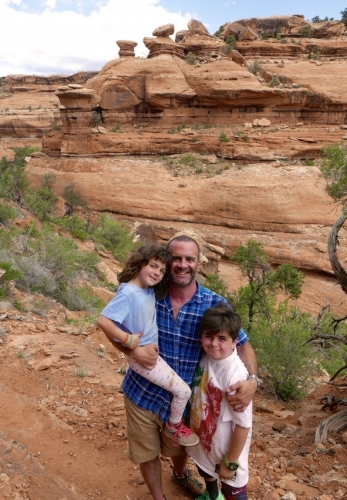John Climaco Climbing in Southeast Utah in the 1980s.
By AAC member John Climaco
Canyonlands first captured me in the spring of 1984 as a skinny, 16-year-old Ohio boy. Years earlier I’d stumbled across a 1966 issue of National Geographic covering the first ascent of the Titan. Entranced by this wild adventure, I stole the only copy from our school library just to have it to myself. I devoured every story of the hard-living desert climbing pioneers I could, but nothing I’d read prepared me for the descent into Indian Creek and the desert of my dreams on my first time. No words could possibly capture the quiet, and the freedom.
In those days, you could have Indian Creek all to yourself on a spring weekend. The Anasazi art and the even more ancient sandstone towers were your silent and only companions. It was a place where you were free to create your own adventures and be the outlaw of your youthful imaginings. Looking back, it recently dawned on me that the very thing which seduced me about the desert may be precisely what imperils it. As the vast emptiness of the desert begets a feeling of endless freedom, it is easy to lapse into a comforting sense of the timelessness of the landscape. It is too easy to let that freedom lull us into assuming that what was here yesterday to be enjoyed today will still be there for us tomorrow.
The fact is that while we see these lands as our birthright, others see them as a vast piggy bank. Whether it was silver to fund a booming new nation, uranium to fuel the cold war or petroleum to fill our tanks, these lands have always held the promise of riches far more bankable than the ephemeral wealth we build there. Only a tiny portion of our public lands are entirely secured from those who wish to tap, mine or drill for personal profit. Would anyone seeking those rewards see our climbing community as a legitimate constituency to be respected and accounted for in use planning and public lands access? Maybe not a generation ago, but things are changing.
Like the echoes of pitons being driven into sandstone, the outlaw era of climbing is gone. Today, climbing is a mainstream sport. The power of our collective voice has grown and so has our capacity to give back to the lands that have given us so much. In speaking together, we have made a significant difference in communicating the value of these lands. The recent Bears Ears National Monument proclamation was the first ever presidential proclamation to list rock climbing as an acceptable and appropriate activity. We spoke up together and we were heard.
Unfortunately, efforts are already underway to dismantle Bears Ears National Monument. The Utah legislature recently passed a resolution, HCR 11, asking the Trump administration to rescind Bears Ears National Monument. Undoing the monument would be unprecedented and would put our other national treasures at risk.
A call to your congressman today will take less time than racking up for tomorrow’s adventures. Thousands of such calls, mainly by hunters and fishermen, recently led Representative Chaffetz (R – UT) to withdraw his disastrous bill which would have allowed a massive transfer of public lands into corporate ownership. If each of us made a single call to protect Indian Creek and the surrounding Bear’s Ears National Monument, could we secure it forever? I’d like to think so.
A few years ago, on yet another climbing and exploring trip from my home in Northern Utah, I saw a sight so incongruous with my sense of the desert landscape I had to stop the car and stare: a drilling rig tapping away yards from the entrance to Canyonlands National Park. I gawked at its gravel containment platform and wondered what law could ever permit this eyesore? Who will clean it up? Was anyone out there who cared enough to do something about it?
Finally, it struck me: I was.
John Climaco today with his children
----------------------
Here's How You Can Take Action:
It is imperative that we communicate our stance on public land policy to our elected representatives. Contact of your federal representatives by calling the Capitol Switchboard: (202) 224-3121 and ask to be connected.
Can’t remember who your representatives are? Look them up here:
U.S. Senate: https://www.senate.gov/
House of Representatives: http://www.house.gov/representatives/
And if picking up the phone terrifies you, consider writing an Op-ed or Letter to the Editor. Not sure where to start? Check out this great resource from our partners at Outdoor Alliance.
----------
For some legal background on the future of Bears Ears, check out AAC Member Taylor Luneau's article Executive Power Over National Monuments


